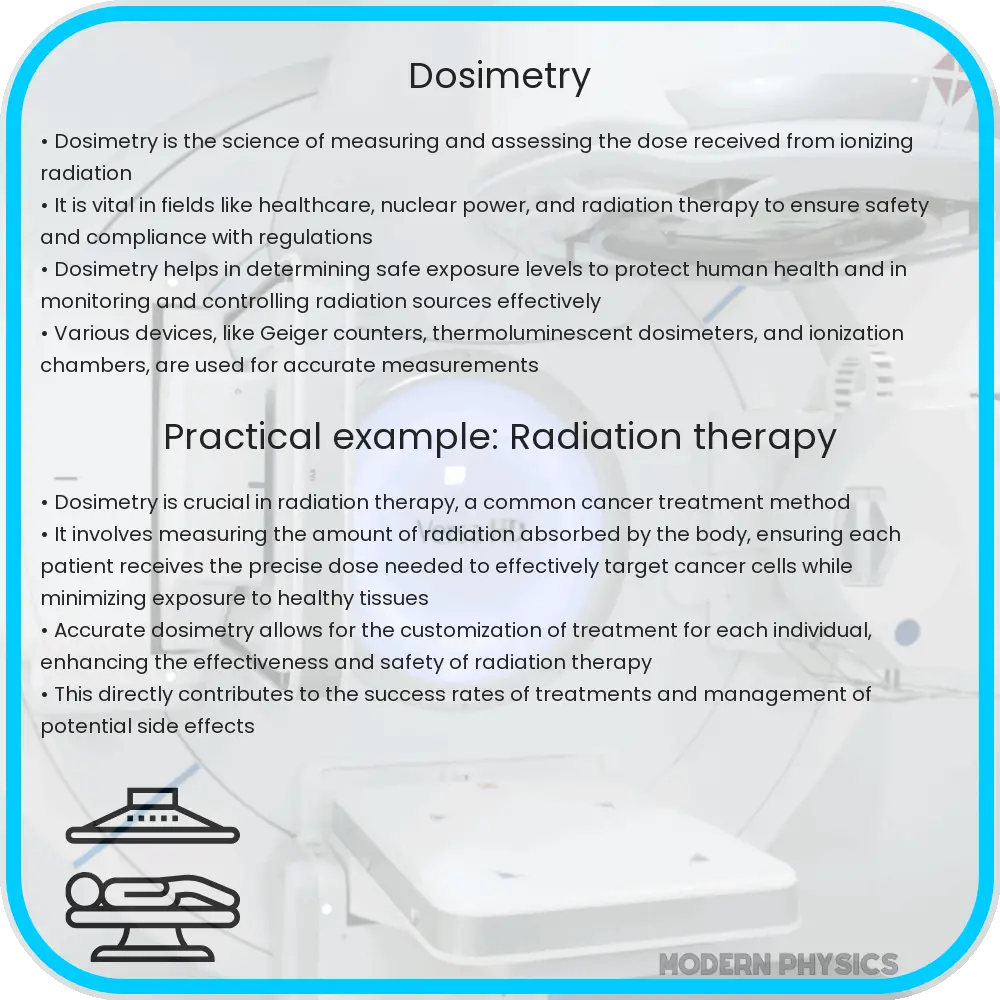Dosimetry: the quantitative measurement of radiation dose absorbed by human tissue in medical physics, crucial in cancer treatment and diagnostic radiology.

Understanding Dosimetry in Medical Physics
Dosimetry is the quantitative assessment of radiation exposure or dose absorbed by human tissue, an essential element in medical physics, particularly in cancer treatment and diagnostic radiology. This field ensures that the applied doses are accurate and safe, aiming to maximize the therapeutic benefits while minimizing adverse effects. Let’s delve into the importance of accuracy and safety in medical dosimetry and examine some of the innovative approaches emerging in the field.
The Role of Accuracy in Medical Dosimetry
Accuracy in dosimetry is paramount. In radiation therapy, precise dose measurement and delivery can mean the difference between successful cancer eradication and significant damage to healthy tissues or organs. Dosimetrists, therefore, must employ sophisticated techniques and technologies to calculate and verify the dose received by patients.
- Thermoluminescent Dosimeters (TLDs): Often used for verification of radiation doses due to their high accuracy and sensitivity.
- Ionization Chambers: Used primarily in calibration procedures, providing high precision in continuous radiation fields.
- Dose Calculation Algorithms: Critical for determining the appropriate three-dimensional dose distribution based on individual patient geometry.
Each method or tool contributes uniquely to ensuring that each radiation treatment is delivered with utmost accuracy.
Safety Concerns in Medical Dosimetry
In medical dosimetry, safety revolves around the careful management of radiation doses to avoid unnecessary exposure both to patients and healthcare professionals. Regulatory standards and protocols are rigorously implemented to prevent dosimetric errors that could lead to severe consequences.
- Quality Assurance (QA) Programs: Establish and monitor adherence to safety criteria, ensuring equipment is functioning correctly, and dosimetric calculations are accurate.
- Personnel Training: Essential in maintaining high safety standards. Dosimetrists and medical physicists are regularly trained on the latest guidelines and technologies.
- Risk Management Strategies: Include rigorous patient monitoring and the application of safety margins during dose calculation and delivery.
With these practices, the prospects of achieving successful outcomes in radiation therapy improve drastically, minimizing risks associated with radiation exposure.
Innovation in Medical Dosimetry
The field of medical dosimetry isn’t static; it constantly evolves with technological advancements and improved understanding of radiation physics. Innovation is paramount in addressing the limitations of current dosimetric practices and enhancing both accuracy and safety. Below are several cutting-edge advancements that are shaping the future of dosimetry:
- Advanced Imaging Technologies: Enhanced imaging such as MRI and PET provide clearer and more detailed views of tumors, allowing for more precise dosimetry.
- Artificial Intelligence (AI): AI is being incorporated into dosimetry to optimize treatment planning and automate complex calculations, potentially reducing errors and improving treatment customization.
- 3D Printing in Dosimetry: The use of 3D printing to create patient-specific phantoms for dose calibration and verification is a growing area of interest.
Each of these innovations holds the promise of revolutionizing the field of dosimetry by improving the accuracy of dose measurements and expanding the capabilities in personalized medicine.
Challenges and Future Directions
Despite the significant advancements in medical dosimetry, challenges still persist that need to be addressed to further enhance patient safety and treatment efficacy. These include dealing with complex tumor geometries, reducing the time required for dose calculations, and managing variabilities in patient responses to radiation.
- Real-time Dosimetry: Developing methods for real-time monitoring of radiation doses could provide immediate adjustments during treatment, enhancing outcomes.
- Greater Customization: Future dosimetry could focus more on personalized approaches considering specific biological effects of radiation on different tissues.
- Integration of Multimodal Data: Combining dosimetric data with genetic and clinical information to better predict and manage patient-specific reactions to radiation treatments.
Addressing these challenges requires ongoing research and collaboration across various scientific disciplines, emphasizing the dynamic nature of medical dosimetry.
Conclusion
In conclusion, medical dosimetry plays a crucial role in the realm of radiation therapy, particularly in the treatment of cancer. The ultimate goals are ensuring the safe and effective delivery of radiation doses, maximizing therapeutic outcomes while minimizing adverse effects. As technology and science advance, so too does the scope of medical dosimetry. Innovations like AI, advanced imaging, and real-time dose monitoring are pushing the boundaries of what is possible, making treatments more precise and personalized.
The journey to perfect dosimetric methods continues as we strive for higher accuracy and safety standards. With each technological advancement and improved understanding of radiation interactions with human tissues, we move closer to achieving more successful and less invasive cancer treatments. It’s an evolving field where precision and responsibility converge to form a cornerstone of modern oncology and radiology.
The future of medical dosimetry is bright, with potential new technologies and methodologies on the horizon promising to further refine this essential area of medical physics. For healthcare providers, patients, and the entire medical community, these advancements signify hope and progression towards more effective and safer therapeutic practices.
